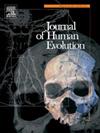肯尼亚Koobi Fora组的生态形态学:用三维几何形态分析重建早更新世人族古环境
IF 3.1
1区 地球科学
Q1 ANTHROPOLOGY
引用次数: 0
摘要
本研究提出了一种新的生态形态学分析方法,利用三维几何形态计量学来量化已知栖息地偏好下现存牛科动物元足的形状变化。现有数据用于创建一个模型,将骨骼分类为不同的栖息地类别,并测试与不同栖息地中运动行为相关的功能假设。然后将该模型应用于肯尼亚Koobi Fora组的化石,以评估人族进化重要事件期间的环境背景。三维几何形态计量学的使用比使用卡尺测量的传统方法有了显著的改进。判别功能分析成功地将94%的掌骨和93%的跖骨划分为现代标本正确的栖息地类别。该方案减少到一个子集的标志集中在远端骨骺。该模型产生了更大的重叠,但分类成功率仍然很高,对现代掌骨和跖骨的分类准确率分别为82%和83%。将简化模型应用于Koobi Fora组Upper Burgi (1.98 ~ 1.87 Ma)、KBS (1.87 ~ 1.56 Ma)和Okote (1.56 ~ 1.38 Ma)段的元跖面。这个位置对了解人类进化、化石多样性和古生态学非常重要。此外,先前关于动物丰度、古土壤碳酸盐和碳同位素的研究为比较本研究的结果提供了一个强有力的框架。我们的分析将大多数化石标本归类为开放式栖息地的居民,少数标本归类为封闭式适应的居民,其中最多的标本属于Okote成员样本。这表明,在早更新世,东图尔卡纳地区主要处于开放和可能的干旱环境。这些发现与之前的许多重建结果一致,尽管与基于动物丰度研究的预期相比,Okote成员的信号更加开放。本文章由计算机程序翻译,如有差异,请以英文原文为准。
Ecomorphology in Kenya's Koobi Fora Formation: Reconstructing Early Pleistocene hominin paleoenvironments with 3D geometric morphometric analyses of bovid metapodials
This research presents a new method of ecological morphology (ecomorphology) analysis using three-dimensional geometric morphometrics to quantify shape variation in extant bovid metapodials with known habitat preferences. Extant data were used to create a model for classifying bones into distinct habitat categories and to test functional hypotheses related to locomotor behavior in different habitats. The model was then applied to fossils from the Koobi Fora Formation, Kenya, to assess the environmental context during important events in hominin evolution. The use of three-dimensional geometric morphometrics demonstrates significant improvement over traditional methods using caliper measurements. Discriminant function analysis successfully classified 94% of metacarpals and 93% of metatarsals into their correct habitat categories for modern specimens. The protocol was reduced to a subset of landmarks focused on the distal epiphyses. This model produced greater overlap, but classification success rates remained high, with 82% and 83% correct classification for modern metacarpals and metatarsals, respectively. We applied the reduced model to metapodials from Upper Burgi (1.98–1.87 Ma), KBS (1.87–1.56 Ma), and Okote (1.56–1.38 Ma) members in the Koobi Fora Formation. This location is important to understanding human evolution, fossil diversity, and paleoecology. Moreover, previous studies on faunal abundance, paleosol carbonates, and carbon isotopes provide a robust framework to compare the findings of this study. Our analyses classified the majority of fossil specimens as open-habitat dwellers, with a few specimens grouped as closed-adapted, the highest number of these falling within the Okote Member sample. This suggests that open and likely xeric environments dominated the East Turkana region during the Early Pleistocene. These findings are consistent with many previous reconstructions, though with a more open signal for the Okote Member than expected based on bovid abundance research.
求助全文
通过发布文献求助,成功后即可免费获取论文全文。
去求助
来源期刊

Journal of Human Evolution
生物-进化生物学
CiteScore
6.30
自引率
15.60%
发文量
104
审稿时长
3 months
期刊介绍:
The Journal of Human Evolution concentrates on publishing the highest quality papers covering all aspects of human evolution. The central focus is aimed jointly at paleoanthropological work, covering human and primate fossils, and at comparative studies of living species, including both morphological and molecular evidence. These include descriptions of new discoveries, interpretative analyses of new and previously described material, and assessments of the phylogeny and paleobiology of primate species. Submissions should address issues and questions of broad interest in paleoanthropology.
 求助内容:
求助内容: 应助结果提醒方式:
应助结果提醒方式:


